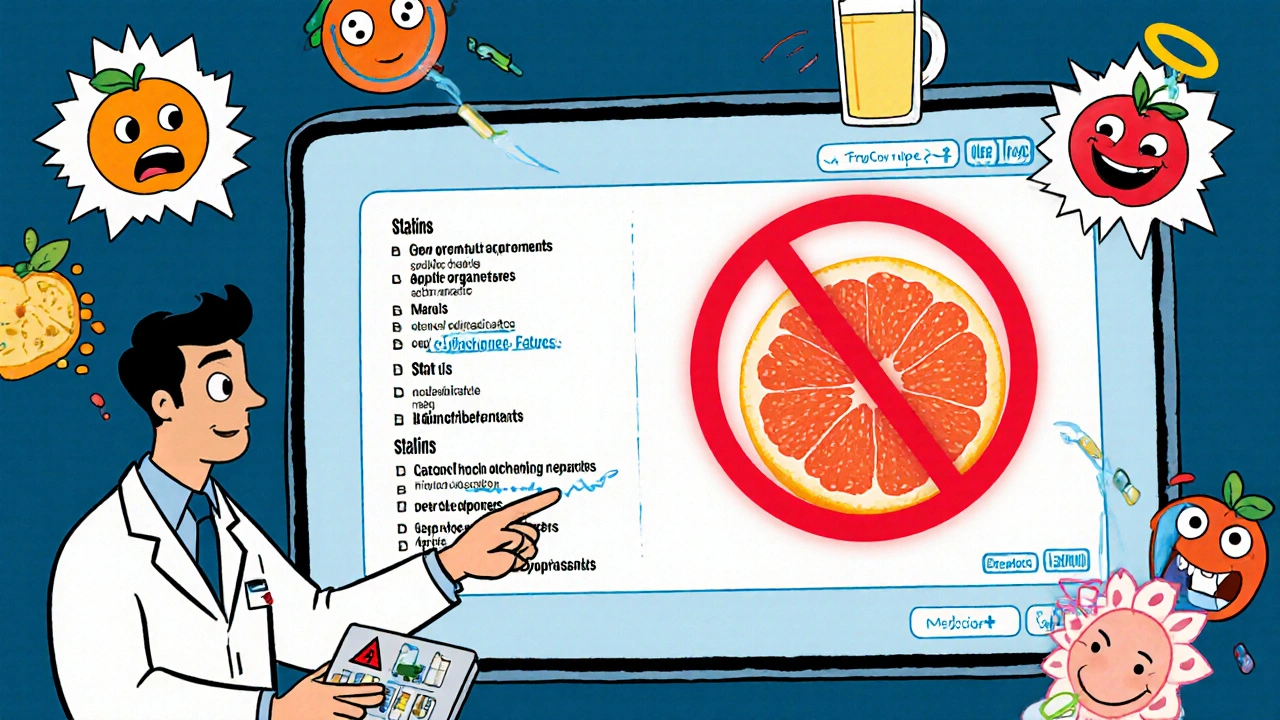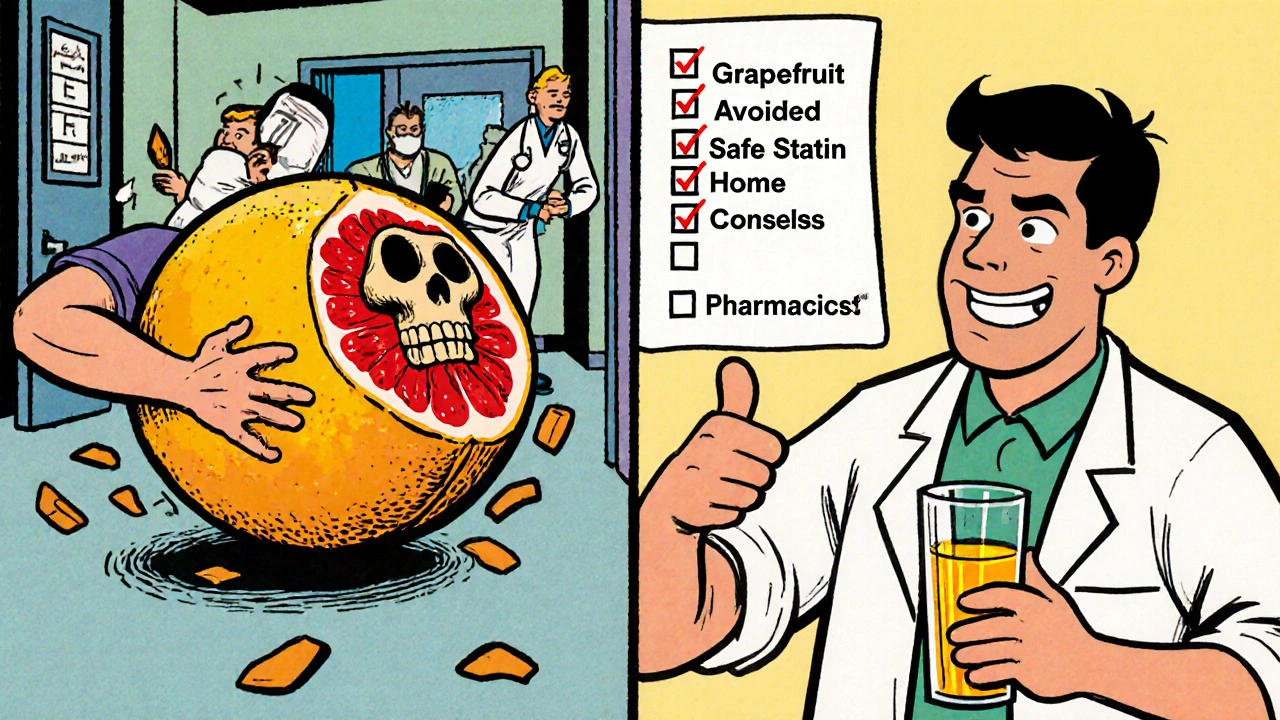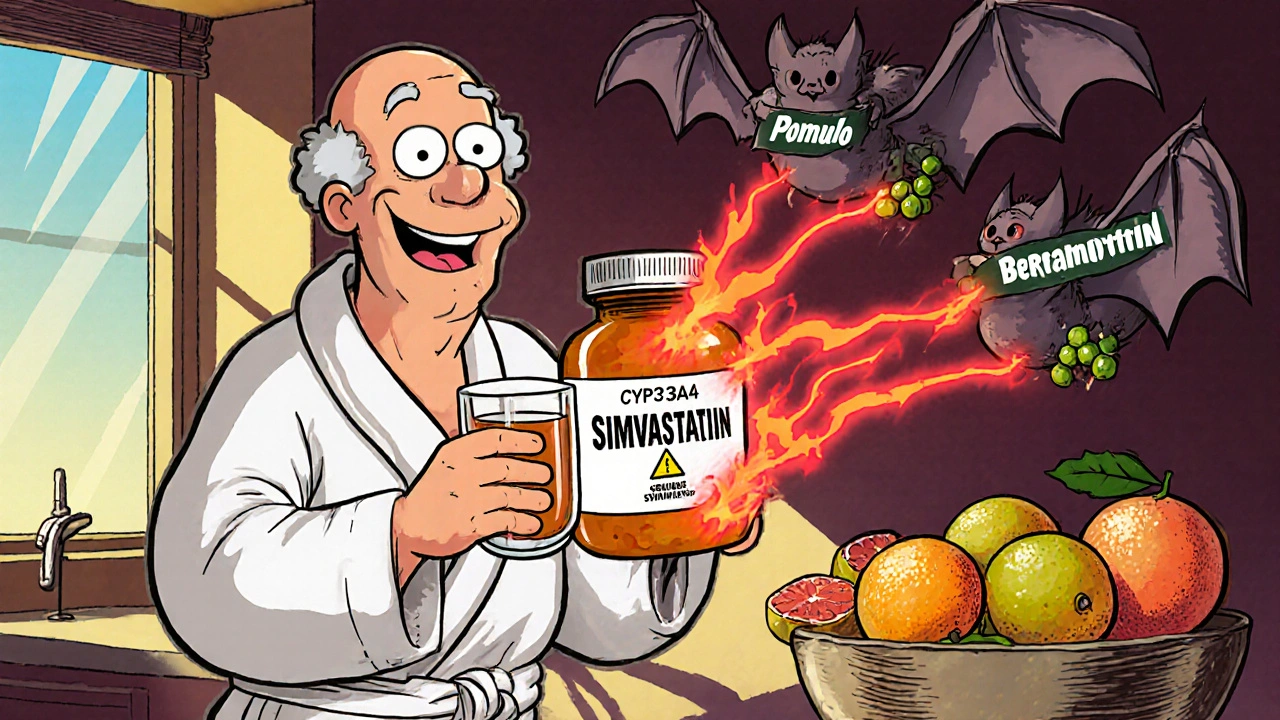Grapefruit Medication Interaction Checker
Check Your Medication for Grapefruit Interaction
Enter your medication name (generic or brand) to see if it interacts with grapefruit and learn about safer alternatives.
Why This Matters
Grapefruit contains compounds that block an enzyme (CYP3A4) in your gut, causing your body to absorb up to 3x more medication than intended. This can lead to serious health risks including kidney failure, heart rhythm problems, and overdose.
The effect lasts 24-72 hours after consuming grapefruit - timing medications hours apart won't help.
Why Grapefruit Can Turn Your Medication Into a Danger Zone
It’s a healthy habit: start your day with a glass of fresh grapefruit juice. But if you’re taking certain medications, that habit could be putting your life at risk. You don’t need to drink a whole gallon - even a single 200-milliliter glass (about 6.7 ounces) can cause serious, sometimes deadly, changes in how your body handles drugs. This isn’t a myth or a warning you hear once and forget. It’s a well-documented, scientifically proven interaction that affects tens of thousands of people every year.
The Science Behind the Warning
What makes grapefruit so dangerous with meds? It’s not sugar. It’s not acid. It’s a group of natural chemicals called furanocoumarins, mainly bergamottin and 6’,7’-dihydroxybergamottin. These compounds attack an enzyme in your gut called CYP3A4. This enzyme normally breaks down a huge number of medications before they enter your bloodstream. When grapefruit shuts it down, your body absorbs way more of the drug than intended.
Unlike some interactions that fade after a few hours, this one lasts for days. Once CYP3A4 is blocked, your body has to make new enzymes to replace them - and that takes 24 to 72 hours. That means even if you take your pill in the morning and drink grapefruit juice at night, you’re still at risk. The damage is done the moment you swallow that juice.
Medications That Can Become Toxic With Grapefruit
Not all drugs are affected. But many of the ones people take daily are. Here are the most common and dangerous categories:
- Statins - These cholesterol-lowering drugs are among the most affected. Simvastatin (Zocor) is the worst offender. One study showed that just three days of daily grapefruit juice triples simvastatin levels in the blood. That raises the risk of rhabdomyolysis - a condition where muscle tissue breaks down and can cause kidney failure. Lovastatin (Mevacor) sees a 1,500% spike in absorption. Atorvastatin (Lipitor) increases by 80%. The good news? Pravastatin (Pravachol) and rosuvastatin (Crestor) are safe. They don’t rely on CYP3A4.
- Calcium Channel Blockers - Used for high blood pressure and angina. Felodipine (Plendil) can jump 355% in blood concentration with grapefruit. Amlodipine (Norvasc) increases by 150%. Nifedipine (Procardia) rises 274%. These spikes can cause dangerously low blood pressure, dizziness, and heart rhythm problems.
- Immunosuppressants - After organ transplants, patients take these to prevent rejection. Cyclosporine (Sandimmune) levels go up 50-60%. Tacrolimus (Prograf) can jump 300-500%. Sirolimus (Rapamune) skyrockets 1,100%. Too much of these drugs can cause kidney damage, high blood pressure, and severe infections.
- Other High-Risk Drugs - Some anti-anxiety meds like buspirone, certain anti-arrhythmics like amiodarone, and even some opioid painkillers like oxycodone can become more potent. Even some cancer drugs, like erlotinib, are affected.
The FDA has flagged 17 specific medications with official warnings on their labels. But there are 23 more with strong evidence in prescribing guides. In total, over 85 medications are known to interact. And new ones are still being discovered.

It’s Not Just Grapefruit
Don’t think you’re safe just because you avoid grapefruit. Other citrus fruits carry the same risk:
- Seville oranges - The kind used in traditional marmalade. They’re packed with the same furanocoumarins.
- Pomelos - A large citrus fruit that’s a close relative of grapefruit. Same danger.
- Wild limes - Not the common Persian limes you find in supermarkets, but certain types grown in specific regions.
- Pomegranate - One case report suggests it might act similarly, though research is still limited.
Orange juice? Apple juice? Cranberry juice? These are generally safe. They don’t contain furanocoumarins. Stick to those if you’re unsure.
Who’s at the Highest Risk?
You’re more vulnerable if you:
- Are over 45 - The older you get, the more likely you are to be on multiple medications.
- Take five or more prescription drugs - Over half of Americans over 65 do.
- Drink grapefruit juice daily - Even small, regular amounts add up.
- Have a genetic variation in CYP3A4 - Some people naturally have less of this enzyme. A 2021 study found those with the CYP3A4*22 allele experience 40% stronger interactions.
The CDC says 52.3% of Americans aged 65+ take five or more prescriptions. The National Health and Nutrition Examination Survey found 42.7% of seniors consume grapefruit weekly. That’s a dangerous mix.
What to Do If You’re on Affected Medications
Don’t panic. You have options.
- Check your medication labels - Look for warnings about grapefruit. If it’s not clear, ask your pharmacist.
- Ask your doctor for alternatives - For statins, switch from simvastatin to rosuvastatin or pravastatin. For blood pressure meds, diltiazem or verapamil may be safer than amlodipine. For immunosuppressants, your doctor can adjust the dose or switch drugs.
- Don’t try to time it - Taking your pill hours before or after grapefruit won’t help. The enzyme shutdown lasts days.
- Use a pill organizer with interaction alerts - Many apps and pharmacy systems now flag grapefruit risks automatically. Ask your pharmacist to set it up.
- Teach your family - If you live with someone, make sure they know why you can’t have grapefruit. Accidental exposure happens.

What Pharmacies and Hospitals Are Doing
This isn’t just a patient problem - it’s a system-wide issue. In 2023, 92.3% of U.S. hospitals using Epic’s electronic health records have automated alerts that pop up when a doctor prescribes a drug that interacts with grapefruit. Community pharmacists screen for this interaction in 78.4% of medication reviews, according to the American Pharmacists Association.
The FDA estimates grapefruit interactions cause about 10,000 adverse events in the U.S. each year - many of them preventable. That’s why drug makers now test new medications for grapefruit interaction during development. Pfizer even reformulated nifedipine to reduce (but not eliminate) the risk.
What’s Next? Science Is Trying to Fix This
Researchers are exploring ways to make grapefruit safer. Early trials show certain farming techniques can reduce furanocoumarin levels by 85-90%. There are also studies looking at whether genetic testing could predict who’s most at risk. But here’s the hard truth: until we have proven, safe alternatives, the only guaranteed solution is to avoid grapefruit entirely.
The American Heart Association says it plainly: "Complete avoidance remains the only recommended strategy for patients taking high-risk medications." There’s no safe amount. No "sometimes". No "just a little". If your drug is on the list, grapefruit has no place in your diet.
Final Checklist: Is Your Medication Safe?
Before you reach for that glass of juice, ask yourself:
- Is my medication on the list of 85+ that interact with grapefruit?
- Do I know the generic name of my drug? (Brand names change - generic names don’t.)
- Have I asked my pharmacist to check for interactions?
- Am I taking more than five medications? If yes, this risk is higher.
- Do I have a safe alternative if I want to keep eating citrus?
If you answered "no" to any of these, talk to your doctor or pharmacist today. One conversation could save your life.
Can I drink grapefruit juice if I take my medication at night and juice in the morning?
No. The enzymes in your gut that break down the medication are blocked for 24 to 72 hours after you consume grapefruit. Even if you space them out by hours or even a full day, the interaction still happens. The only safe approach is to avoid grapefruit entirely while taking affected drugs.
Is grapefruit juice worse than eating the whole fruit?
It’s about the same. The active compounds - furanocoumarins - are in both the juice and the pulp. Some people think eating the fruit is safer because it’s less concentrated, but studies show the effect is just as strong. Whether you drink it or eat it, the risk is identical.
What if I only have grapefruit once a week?
Even occasional use can be dangerous. One glass can shut down your CYP3A4 enzymes for days. If you’re on a daily medication, that means you’re constantly exposing yourself to higher drug levels. There’s no safe frequency - only total avoidance.
Are there any safe citrus fruits I can have instead?
Yes. Regular oranges (like navel or Valencia), tangerines, and most common limes (Persian limes) are safe. They don’t contain furanocoumarins. Apple juice, cranberry juice, and tomato juice are also fine. Stick to these if you’re looking for a citrusy alternative.
Can I switch to a different statin to avoid the interaction?
Absolutely. If you’re on simvastatin or lovastatin, ask your doctor about switching to pravastatin or rosuvastatin. These statins are metabolized differently and don’t interact with grapefruit. Many patients make this switch successfully and still get the same cholesterol-lowering benefits without the risk.
How do I know if my medication is affected?
Check the patient information leaflet inside your pill bottle. Look for "grapefruit" or "citrus" in the warnings. If it’s not clear, ask your pharmacist - they’re trained to spot these interactions. You can also use the FDA’s online database or ask your doctor to run a quick check during your next visit.
Why isn’t this warning on every grapefruit package?
Regulations don’t require food labels to warn about drug interactions - only pharmaceutical companies must label their medications. That’s why so many people are caught off guard. It’s up to you and your healthcare provider to connect the dots. Don’t assume the fruit is safe just because it doesn’t say otherwise.
What should I do if I accidentally drank grapefruit juice with my medication?
Don’t panic, but don’t ignore it either. If you’re on a high-risk drug like simvastatin, cyclosporine, or tacrolimus, watch for signs of overdose: unexplained muscle pain, weakness, dark urine, dizziness, or irregular heartbeat. Call your doctor or pharmacist immediately. They may want to check your blood levels or adjust your dose. Going forward, avoid grapefruit completely.


Comments (9)
Zachary Sargent
30 Oct, 2025I took simvastatin for years and never knew this. One glass of grapefruit juice and boom - muscle pain so bad I couldn’t walk. Turned out my doctor never mentioned it. Don’t assume they know. Always ask.
Eileen Choudhury
31 Oct, 2025This is why I switched to orange juice. I used to love grapefruit like it was liquid sunshine 🌞 but now? I just smile at it from afar. My cholesterol’s stable, my kidneys are happy, and I still get my citrus fix. No regrets.
Also - pomelos are sneaky. My cousin in Mexico thought they were "just big oranges" and ended up in the ER. Don’t be that person.
Pradeep Kumar
31 Oct, 2025In India, we don’t drink much grapefruit juice but we do eat the fruit sometimes. My uncle on statins didn’t know about this until his doctor asked him point blank. Now he eats mangoes instead. Life’s too short to be scared of food - but not too short to be careful. 🙏
Matthew Kwiecinski
2 Nov, 2025The science here is solid but oversimplified. CYP3A4 inhibition isn’t binary. Individual variation in enzyme expression, gut microbiome composition, and genetic polymorphisms like CYP3A4*22 significantly modulate the magnitude of interaction. Not everyone responds the same. Population-level warnings are necessary but don’t replace personalized risk assessment.
Andy Ruff
2 Nov, 2025People are still drinking grapefruit juice with their meds? Are you kidding me? This isn’t some obscure Reddit myth - it’s in the damn FDA label. If you’re too lazy to read your pill bottle, don’t blame the fruit. Blame your own ignorance. You think your grandma’s 17 prescriptions are going to magically be safe because you like the taste? Wake up.
Melissa Kummer
3 Nov, 2025As a pharmacist, I’ve seen this firsthand. A 72-year-old woman on cyclosporine drank grapefruit juice every morning for six months. She didn’t feel sick - until her creatinine spiked. We had to hospitalize her.
There’s no "sometimes". No "just once". No "I’ll drink it after my pill". It’s not about timing. It’s about biology.
Always check with your pharmacist. Even if your doctor doesn’t mention it.
Justin Vaughan
5 Nov, 2025I used to think grapefruit was just a fancy breakfast thing. Then my dad had a heart transplant and we found out he was on tacrolimus. We went from daily grapefruit smoothies to... apple juice.
It’s not about giving up flavor - it’s about keeping your body alive. I started making my own citrus blends with oranges, tangerines, and a splash of lime. Tastes great, no risk.
Also - if you’re on five meds? Make a list. Print it. Tape it to your fridge. Your future self will thank you.
Manuel Gonzalez
7 Nov, 2025I had no idea pomegranate might be a problem. Just checked my bottle - no warning. But I’m not taking any chances. I switched to cranberry juice. Tastes different, but I’m alive.
Also, if you’re wondering if your meds are affected, Google the generic name + "grapefruit interaction". It’s faster than calling your doctor. Just don’t rely on random forums. Use MedlinePlus or the FDA site.
andrea navio quiros
8 Nov, 2025The enzyme inhibition is irreversible and requires de novo synthesis which takes 24 to 72 hours so even if you space the intake you are still at risk because the enzyme pool is depleted and the drug bioavailability remains elevated until new enzyme is produced this is not a pharmacokinetic interaction you can time out of it the only safe strategy is avoidance and this is not an exaggeration it is a biological reality grounded in pharmacology and clinical evidence and if you think you are an exception you are probably wrong